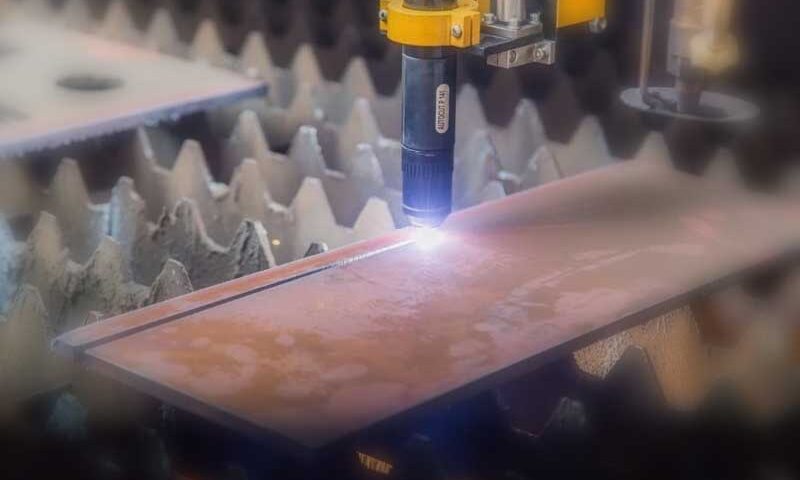Diving into the heart of metalworking, laser cutting has established itself as an essential process in the industry. Broadly, metal laser cutting is a fabrication process that uses a concentrated laser beam to cut or engrave high-precision parts from a metal sheet or a metal workpiece. This technology has been refined to achieve high precision, speed, and quality in cutting a wide range of materials, including stainless steel, carbon steel, aluminium, copper, brass, and more.
The process begins with the laser cutting machine directing a high-power laser beam at the selected metal surface. As the beam scans the surface, it rapidly heats, melts, and vaporises the material. A jet of assist gas then blows the molten material away, leaving a clean, sharp edge.
A few key factors influence the quality of cutting. Firstly, laser power and speed significantly affect the cutting quality. Higher power and slower speed result in deeper cuts, while lower power and faster speed produce shallower cuts. Secondly, the focus spot size—the smallest spot that a laser beam can be focused into—also plays a vital role. The smaller the focus spot size, the higher the intensity of the laser, and thus, the better the cutting quality. Lastly, the type of assist gas used—be it oxygen, nitrogen, or compressed air—can significantly impact the cut edge quality and the cutting speed.
- Laser metal cutting technology
- Factors affecting the quality of cutting
- Laser metal cutting advantages
- Laser cutting machines for metal
- CO2 lasers
- Fiber lasers
- Metal materials for cutting
- Laser cutter device
- Processing after laser cutting
1. Laser Metal Cutting Technology
Central to metalworking, laser cutting is a process that uses a concentrated laser beam to cut or engrave intricate parts from a metal workpiece. This process commences as the machine projects a high-power laser beam on the selected metal surface. As the beam sweeps over the surface, it swiftly heats, melts, and vaporises the material. An assist gas then propels the molten material away, ensuring a clean, well-defined edge.
2. Factors Affecting the Quality of Cutting
Several key elements influence the quality of cutting. Firstly, the power of the laser and its speed play significant roles. Higher power and slower speed yield deeper cuts, whereas lower power and faster speed lead to shallower cuts. Secondly, the focus spot size – the smallest achievable spot of a laser beam – is critical. The smaller the focus spot size, the higher the laser’s intensity, thereby enhancing the cutting quality. Lastly, the choice of assist gas used, whether oxygen, nitrogen, or compressed air, significantly affects the cut edge quality and the speed of cutting.
3. Laser Steel Cutting Advantages
Steel laser cutting comes with an array of benefits. It offers remarkable precision, enabling the cutting of complex shapes and intricate details with minimal metal deformation. Its efficiency is noteworthy, as one machine can cut various parts, optimising production speed and minimising waste. Moreover, its versatility makes it suitable for a broad spectrum of metals and alloys.
4. Laser Cutting Machines for Metal
Two principal types of machines are used in laser metal cutting: CO2 lasers and fiber lasers.
5. CO2 Lasers
CO2 lasers employ a gas mixture, primarily comprising carbon dioxide, electrically stimulated to generate a laser beam. These machines offer excellent beam quality, high cutting speed, and reliable performance. They are particularly effective for cutting, engraving, and shaping thicker metal materials.
6. Fiber Lasers
Fiber lasers utilise an optical fiber laced with rare-earth elements such as ytterbium to create a laser beam. They deliver high energy efficiency, extraordinary speed, and require less maintenance than CO2 lasers. These machines are especially proficient at rapidly and efficiently cutting thin metal materials.
7. Metal Materials for Cutting
A wide array of metal materials is available for laser cutting. Stainless steel is often chosen due to its rust and corrosion resistance. Carbon steel, renowned for its hardness and strength, is suitable for parts demanding durability. Aluminium, albeit softer than steel, is lightweight and highly malleable, making it a preferred choice for automotive and aerospace applications.
8. Laser Cutter Device
The laser cutter device, the heart of these machines, consists of three primary parts: the laser, the cutting head, and the control system. The laser generates the beam; the cutting head focuses the beam and releases the assist gas; and the control system manages the machine’s movement and the cutting process.
9. Processing After Laser Cutting
Following laser cutting, the metal parts usually undergo additional processing. Depending on the final use of the part, this could involve welding, bending, painting, or coating. Welding is a particularly common subsequent process, as it allows multiple laser-cut pieces to be assembled to create complex structures. This entire process embodies the precision, efficiency, and versatility that makes metal laser cutting a pivotal technology in the metalworking industry.
Laser Cutting technological advancements in the metal fabrication industry
With rapid technological advancements in the metalworking industry, the rise of laser cutting technology has been a game-changer. Offering exceptional precision, speed, versatility, and quality, laser cutting has reshaped traditional methods of metal fabrication. The meticulous, intricate details and complex shapes achievable by this technique would be unimaginable through conventional methods. The reduced waste, optimized production speed, and extensive application range further reinforce the superiority of laser cutting in contemporary metalworking practices.
The specific strengths of both CO2 and fiber lasers underscore the technological diversity in the field. CO2 lasers, with their excellent beam quality and speed, cater well to thicker materials, ensuring robust performance across various applications. Fiber lasers, distinguished by their energy efficiency and maintenance ease, demonstrate remarkable aptitude in handling thinner materials, allowing for quick, efficient outputs.
The flexibility in metal material choices, from stainless steel, carbon steel to aluminium, affirms the all-encompassing versatility of laser cutting. It underscores the technology’s capacity to adapt to different material characteristics, serving a myriad of industry needs ranging from construction and automotive to aerospace sectors.
The laser cutter device itself, a marvel of engineering, embodies the precision and efficiency that make this technology so valuable. Its three core components – the laser, cutting head, and control system – work harmoniously, each playing a critical role in the cutting process.
Post-cutting processes, such as welding, further extend the value chain, allowing laser-cut pieces to be assembled into complex structures. Thus, the technology’s impact extends beyond mere cutting, playing a crucial role in broader manufacturing processes.
In essence, the future of metalworking lies in harnessing and further developing laser cutting technology. It stands as a testament to human innovation, driving industry standards forward while enabling new possibilities in metal laser cutting design and Structural Steel Fabrication. For Australia, and indeed the world, this is just the beginning. As technology evolves, the capabilities, efficiency, and reach of laser cutting will only grow, charting new paths in the metalworking industry.

